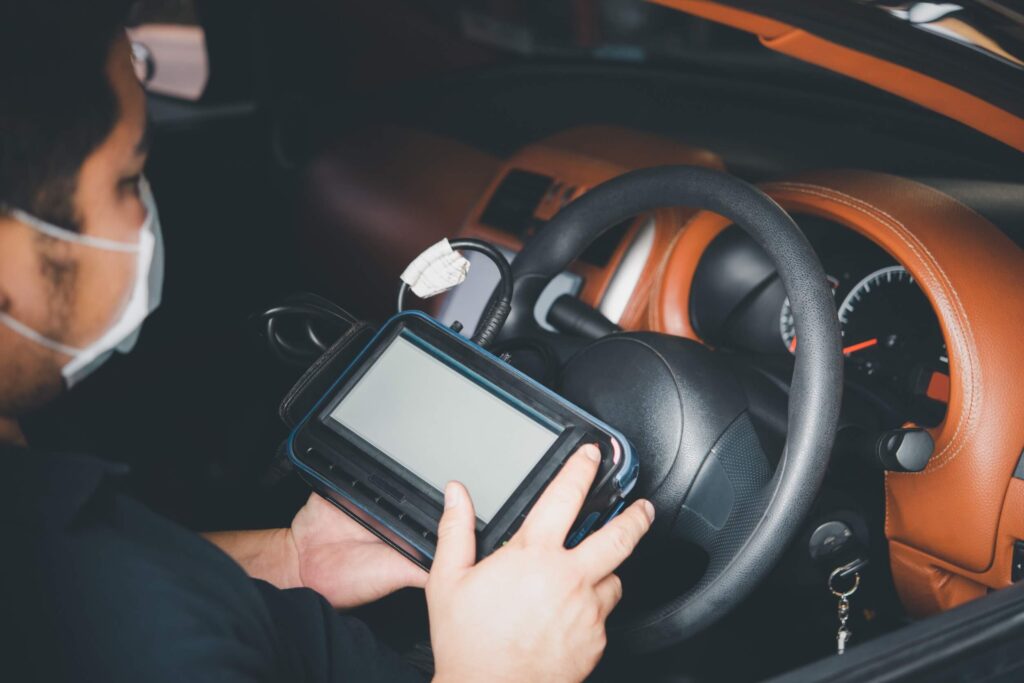The check engine light is an important indicator in modern vehicles that alerts drivers to potential issues. Disconnecting the car’s battery is often thought of as a quick fix to turn off the check engine light, which it can do but often just temporarily masks an underlying issue.
In this article, we explore the relationship between battery disconnection and the check engine light, provide the correct way to reset the light, and address concerns about potential damage or risks.
Understanding the Check Engine Light
The check engine light is actually an emissions warning light (not many people know this); it alerts you there is a fault. If you continue, you are driving and releasing the incorrect exhaust emissions that will damage the catalytic converter or DPF. Depending on the cause, you may also find the car will enter limp mode, restricting engine power, revs, and the speeds you can achieve.
Once the light is triggered, the car ECU stores the triggered fault code. The light will continue to display until the ECU senses the fault has disappeared, which can happen if it was a minor sensor issue that has solved itself, or until it is manually cleared after a repair. If the fault code continues to display or returns after clearing, the fundamental issue remains, and the fault needs to be repaired before attempting to reset the light again.
Does Disconnecting the Battery Turn off the Check Engine Light?
Yes, disconnecting the battery will turn off the check engine light in most vehicles. Although this method will work in most, it won’t work in every car, and sadly, there is no way of telling which car it will work on or won’t.
When you disconnect and reconnect the battery, the car’s ECU resets all systems, provided you do it correctly(I will come on to that later); hence, the clock will need resetting, etc. This is no different from the check engine light; it will perform a reset, switching off the light.
However, here is the issue: if the fault remains, as soon as you start the vehicle and drive it down the road, the car ECU will detect the problem is still there and throw the check engine light back on.
Will Disconnecting the Battery Clear a Fault Code?
There are certain instances where disconnecting the battery can clear a fault code. Let me give you a scenario; let’s say you disconnect an o2 sensor and then start the car; the check engine light will come on, and a fault code will be stored. But if you reconnect the o2 sensor, the check engine light will remain, but the fault is now rectified. If you then disconnect the battery and do the whole procedure correctly, once the battery is reconnected, you will find the car recognizes there is no longer a fault. The engine management light will turn off and may remove the stored fault code.
Unfortunately, there are no guarantees that this will work for every car or every scenario; you may find disconnecting the battery will not clear the fault code. This is usually because the fault still needs to be rectified or because of the nature of the fault. The car cannot tell if it has been solved, so it keeps the light on and the fault code stored to protect itself.
How to Safely Disconnect the Battery?
- Locate the battery and identify the negative (-)(black cable) and positive (+) (red cable) terminals.
- Use a wrench or pliers to loosen the nut or bolt holding the negative cable in place.
- Carefully remove the negative cable from the battery terminal and secure it away from the battery so that it does not accidentally come into contact with the terminal or any metalwork.
- Repeat the same process with the positive cable.
- Check the battery cables for any signs of corrosion or damage and clean them if needed.
- Store the disconnected cables safely away from the battery terminals and metal surfaces.
How Long Should You Leave the Battery Disconnected?
Once you have the battery disconnected, wait for at least 10-15 minutes before attempting to reconnect the battery to allow any residual electrical charges to dissipate.
A residual charge will keep the electrical system active even after the battery is disconnected and can potentially cause damage to sensitive electronic components if not given enough time to dissipate. But in this instance, waiting 15 minutes will give the ECU enough time to dissipate any residual charge, improving the chances of resetting the engine warning light when you reconnect the battery.
Reconnecting the Battery
- Locate the negative (-) (black cable) and positive (+) (red cable) terminals.
- Reconnect the positive cable first and tighten the nut or bolt holding it.
- Reconnect the negative cable next and tighten the nut or bolt to secure it.
- Once both cables are reconnected, start the car and check if the check engine light has been reset.
Remember never to simultaneously touch the positive and negative cables when disconnecting or reconnecting the battery.
Does Disconnecting the Battery Cause Damage?
Disconnecting the battery itself should not cause any damage as long as it is done correctly. However, if the battery is disconnected incorrectly or the cables touch together, it can cause damage to the vehicle’s electrical system. Following the correct procedure when disconnecting and reconnecting the battery is vital to avoid any potential damage.

Correct Way to Reset a Check Engine Light
To reset your car’s check engine light correctly, you need to use a diagnostic tool. This tool connects to the car’s ECU through an OBD port and reads stored fault codes. If the issue causing the fault has been fixed, you can remove the code and reset the check engine light.
If you have tried to disconnect the battery to reset the check engine light or clear a fault code and it didn’t work, you will need to use a diagnostic tool to reset the light correctly.
Final Thoughts
Disconnecting the battery can turn off the check engine light, but it is not a permanent solution, as the light will come back on if the underlying issue is not fixed. While disconnecting the battery can sometimes clear fault codes, it is not a guaranteed fix. Therefore, it is always best to properly diagnose and repair the issue before resetting the check engine light. If you decide to disconnect the battery, it is essential to follow the correct procedure to avoid damaging the vehicle’s electrical system and ensure a safe and successful reset.










One important note on the check engine light. As the article mentions it is more accurate to say check emission systems. The emission systems carry a Federal Mandated 10 year 100,000 mile warranty so it is very possible your cars problem is covered by the cars manufacturer warranty by brand. So you would have nothing to lose by driving to the dealer for your car brand and asking them to check the car which they will do for no charge by law. Their computer hook up to your car will tell them all faults and they can fix them under the above warranty.
Thanks for your comment. You are absolutely right, depending on the age of the car you could take it back it to the dealer and see what they have to say about it. Won’t get you anywhere in most situations but as you say you may not have anything to lose by trying.
Regards
Tommy
carsneedcare.com